Westlyn, Lincoln, Friday evening and Saturday morning, 4-5 August 2000:
 We stopped for lunch Thursday in Gargrave, on the southern edge of the Yorkshire Dales National Park. We parked right beside a lock on the Leeds and Liverpool Canal, just in time to see it let two of these canal boats through.
We stopped for lunch Thursday in Gargrave, on the southern edge of the Yorkshire Dales National Park. We parked right beside a lock on the Leeds and Liverpool Canal, just in time to see it let two of these canal boats through.
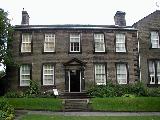
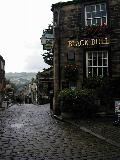 We detoured into Haworth, where we visited the Brontë parsonage (left), and saw this pub where Branwell all too frequently resorted until the tuberculosis got him. The parsonage is now a Brontë museum, and a very good one. I discovered, what I had not known, that the reverend Brontë paterfamilias was born Patrick Prunty or Brunty in County Down, in Ireland--sure it's no wonder there was all that literary genius in the genes! The familiar form of the surname was apparently copied by him from a title awarded to Lord Nelson.
We detoured into Haworth, where we visited the Brontë parsonage (left), and saw this pub where Branwell all too frequently resorted until the tuberculosis got him. The parsonage is now a Brontë museum, and a very good one. I discovered, what I had not known, that the reverend Brontë paterfamilias was born Patrick Prunty or Brunty in County Down, in Ireland--sure it's no wonder there was all that literary genius in the genes! The familiar form of the surname was apparently copied by him from a title awarded to Lord Nelson.
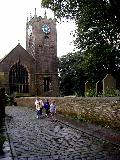
 Most of the talented sib-ship are buried in the church to which the parsonage belongs and faces; but we did not venture in to view the graves. No prizes for guessing what time of day we were there, or how long we spent in the parsonage.
Most of the talented sib-ship are buried in the church to which the parsonage belongs and faces; but we did not venture in to view the graves. No prizes for guessing what time of day we were there, or how long we spent in the parsonage.
 Thursday night we got in late to our dairy-farm B&B, thanks in part to snail-paced service at the places we had picked to lunch and dine. When we arrived, we discovered that I had reserved the place for the wrong date, and it was full. Fortunately the landlady had called around among her colleagues (after puzzling over my call saying we'd be late) and had found us another place, where we were accommodated very well and where I photographed the beautiful front garden in the early morning light.
Thursday night we got in late to our dairy-farm B&B, thanks in part to snail-paced service at the places we had picked to lunch and dine. When we arrived, we discovered that I had reserved the place for the wrong date, and it was full. Fortunately the landlady had called around among her colleagues (after puzzling over my call saying we'd be late) and had found us another place, where we were accommodated very well and where I photographed the beautiful front garden in the early morning light.
Friday was a wonderful day. We visited two great gothic minsters and their still distinctly medieval environs. We Americans seem to have a peculiar longing for the medieval, our continent having lurched all too suddenly and violently from the Stone Age into the European sixteenth century. I overheard some young Italians in Edinburgh commenting about the way "Americani" go gaga over anything that might be termed a "castello." Perhaps it is because we encounter castles so much in story but never in reality, unless and until we cross the Atlantic--apart from the odd fantasy/caricature perpetrated by Disney or some other cracked tycoon. I had a student once who cherished the fond notion that his Dungeons and Dragons hobby somehow constituted a cultural link with the Middle Ages. If people feel deprived of the Middle Ages they will sometimes go to strange lengths to fill the void. Witness John Bunyan, who with Pilgrim's Progress seemingly undertook to give Protestantism a medieval dream-allegory to call its own, centuries after the time for such stuff was past.

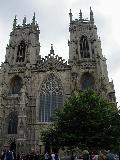 We started our day with York. I remembered that central York was by no means automobile-compatible, and so we availed ourselves of the wonderful park-and-ride service they have set up to get around the problem. The bus dropped us off right at the foot of the oldest and narrowest of the medieval streets, the Shambles (left), through which we made our way towards the great church. It was the first time Stas or the children had ever seen a genuine medieval gothic cathedral in the flesh. This their first is the biggest of them north of the Alps, and particularly impressive inside, with its unbelievably lofty vaulted ceilings (especially in the central tower), and its great west window with heart-shaped tracery and fourteenth-century stained glass. The outside is also impressive, and I saw it now for the first time without scaffolding. (The latest batch of the unending repair work had been completed and the scaffolding removed just in time for a royal visit a week before, I heard.)
We started our day with York. I remembered that central York was by no means automobile-compatible, and so we availed ourselves of the wonderful park-and-ride service they have set up to get around the problem. The bus dropped us off right at the foot of the oldest and narrowest of the medieval streets, the Shambles (left), through which we made our way towards the great church. It was the first time Stas or the children had ever seen a genuine medieval gothic cathedral in the flesh. This their first is the biggest of them north of the Alps, and particularly impressive inside, with its unbelievably lofty vaulted ceilings (especially in the central tower), and its great west window with heart-shaped tracery and fourteenth-century stained glass. The outside is also impressive, and I saw it now for the first time without scaffolding. (The latest batch of the unending repair work had been completed and the scaffolding removed just in time for a royal visit a week before, I heard.)
 In honor of the hundredth birthday of the Queen Mum, the Minster rang for the first time a brand-new set of six bells. From them we heard, among other things, "Loch Lomond," which in this case took us back a mere ten days. From the King's Division Waterloo Band, playing before the west door of the Minster, we heard among other things the theme from the James Bond movies--that treasured vestige of the imperial greatness into which the birthday girl was born a century ago.
In honor of the hundredth birthday of the Queen Mum, the Minster rang for the first time a brand-new set of six bells. From them we heard, among other things, "Loch Lomond," which in this case took us back a mere ten days. From the King's Division Waterloo Band, playing before the west door of the Minster, we heard among other things the theme from the James Bond movies--that treasured vestige of the imperial greatness into which the birthday girl was born a century ago.
On the way from York to Lincoln we passed over the great suspension bridge across the Humber estuary, which till recently boasted the longest single span in the world. We also encountered what I think is my new all-time favorite English town name: "Spital on the Street." At the last I slowed down to get some distance from a van that was blocking the view ahead, since I love the distant prospect of Lincoln Cathedral towering over the town--which many gothic cathedrals were originally designed to do but no longer can manage.
 The obvious thing to say about this irreverent pub sign spotted in Lincoln is "We are not amused"--but that would be a lie.
The obvious thing to say about this irreverent pub sign spotted in Lincoln is "We are not amused"--but that would be a lie.
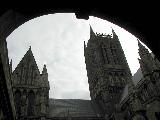 Aside from the distant prospect, what makes Lincoln one of my very favorite English cathedrals is the endless abundance and variety of figurative detail, the hundreds of expressive medieval carvings of faces especially. Despite its seemingly rigid hierarchies of lords temporal and spiritual, the culture that produced this cathedral seems to have allowed many artisans over many centuries to adorn the great fabric with whatever faces peopled their own individual lives and imaginations. Most are in stone, some on vault bosses too high to be seen without binoculars (which of course did not exist when they were carved). The cloister, however (from which this photo was taken), features a 700-year-old wooden vault with carved bosses much lower down and thus easier to see, featuring a lot of faces and strange scenes and creatures.
Aside from the distant prospect, what makes Lincoln one of my very favorite English cathedrals is the endless abundance and variety of figurative detail, the hundreds of expressive medieval carvings of faces especially. Despite its seemingly rigid hierarchies of lords temporal and spiritual, the culture that produced this cathedral seems to have allowed many artisans over many centuries to adorn the great fabric with whatever faces peopled their own individual lives and imaginations. Most are in stone, some on vault bosses too high to be seen without binoculars (which of course did not exist when they were carved). The cloister, however (from which this photo was taken), features a 700-year-old wooden vault with carved bosses much lower down and thus easier to see, featuring a lot of faces and strange scenes and creatures.


 Some of the earliest carvings (or restorations thereof) are to be found on this ornate Norman-period portal, the main west door of the church (with the Kings of England carved in full figure above it). The fall of man is from a column on the left. The whimsical beasts or demons with their tongues sticking out form the innermost carved molding of the doorway. (These three actually appear sideways, on the right-hand post, with the tongues towards the doorway opening.)
Some of the earliest carvings (or restorations thereof) are to be found on this ornate Norman-period portal, the main west door of the church (with the Kings of England carved in full figure above it). The fall of man is from a column on the left. The whimsical beasts or demons with their tongues sticking out form the innermost carved molding of the doorway. (These three actually appear sideways, on the right-hand post, with the tongues towards the doorway opening.)
Ba Ba Guest House, Chester, Sunday afternoon, 6 August 2000:
Last night in Buxton, Derbyshire, we went to the wonderful Victorian opera house for The Gondoliers, part of the nearly month-long Seventh International Gilbert & Sullivan Festival. The company was a sort of ad hoc professional G&S troupe, called simply The Gilbert & Sullivan Opera Company, which I gather exists only at and during the festival. We got to our seats early so I could at least try to participate in the "singing from the gallery," an old G&S first-night custom now in revival there for the Saturday night performances of the professional productions. We had very good seats in the very front and near the center of the second balcony. The children had to stand or kneel much of the time in order to see over the front wall, but they could do so without bothering anyone (much), and probably preferred it over sitting still that long. The kids were wonderful and did nothing to embarass us.
Whether I embarassed them is perhaps another question, though here might be a positive advantage to their being so young yet. The gallery sing was led from the stage by a jovial fellow not without sarcasm ("Do you know any Gilbert & Sullivan?"), and while I felt I made a creditable contribution in the bass line of the madrigal "Brightly Dawns Our Wedding Day," all too many of the selections were rather involved ensemble or choral numbers (including some from Iolanthe and The Sorcerer) that I had never had occasion to learn for performance, so I kept pretty quiet. I guess he was counting on an audience of ten-year veterans of amateur G&S company choruses. After that, the same man read bits of a favorable Manchester review of the previous Saturday evening's performance, and dropped some names of distinguished Savoyards in the audience including Thomas Round in the gallery, and John Reed, whose deprecating hand fluttered briefly from a dress-circle box to acknowledge the applause. Next he brought before the curtain (yes, there was a proscenium curtain in actual use) an actor done up as Richard D'Oyly Carte from the old Spy (or was it Ape?) caricature, complete with rolled plans for the Savoy under his arm. He in turn introduced the music director, who launched into the national anthem before the overture, just as the old Savoy custom was.
The production itself was pretty solidly traditional too, though it did seem a trifle odd for the male Baratarian courtiers to be dancing their "Cachucha, Fandango, Bolero" in frock coats and bowlers or toppers rather than in either gondolier or court costume. The stage business tended to recall the D'Oyly Carte company's, even down to some distracting Ducal antics involving food during the Grand Inquisitor's song of essential exposition ("I Stole the Prince"). The sets were a bit less lavish and the dance routines a little less polished than in the D'Oyly Carte productions I remember from a quarter century ago, but still it says something good when that is the comparison that springs to mind. Overall it was very well and solidly done. The voices were all good and strong (Luiz was my favorite, followed by Giuseppe and Marco, but there were no weak links anywhere); the diction was clean from beginning to end; and the whole thing was pulled off with considerable comic flair. We all enjoyed it thoroughly.
previous entry
next entry
main/ToC page

 We detoured into Haworth, where we visited the Brontë parsonage (left), and saw this pub where Branwell all too frequently resorted until the tuberculosis got him. The parsonage is now a Brontë museum, and a very good one. I discovered, what I had not known, that the reverend Brontë paterfamilias was born Patrick Prunty or Brunty in County Down, in Ireland--sure it's no wonder there was all that literary genius in the genes! The familiar form of the surname was apparently copied by him from a title awarded to Lord Nelson.
We detoured into Haworth, where we visited the Brontë parsonage (left), and saw this pub where Branwell all too frequently resorted until the tuberculosis got him. The parsonage is now a Brontë museum, and a very good one. I discovered, what I had not known, that the reverend Brontë paterfamilias was born Patrick Prunty or Brunty in County Down, in Ireland--sure it's no wonder there was all that literary genius in the genes! The familiar form of the surname was apparently copied by him from a title awarded to Lord Nelson. We stopped for lunch Thursday in Gargrave, on the southern edge of the Yorkshire Dales National Park. We parked right beside a lock on the Leeds and Liverpool Canal, just in time to see it let two of these canal boats through.
We stopped for lunch Thursday in Gargrave, on the southern edge of the Yorkshire Dales National Park. We parked right beside a lock on the Leeds and Liverpool Canal, just in time to see it let two of these canal boats through.










